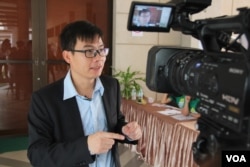Laos will begin its chairmanship of Asean in January, the year when economic integration across the region begins.
Officials say the land-locked country can serve as a model for connectivity, helping the region focus on the development gap between the rich and poor countries of Asean.
“Laos is a landlocked country and, as such, has to focus on connecting road network infrastructure to become ‘land-linked’ instead,” Chheang Vannarith, a lecturer in Asia-Pacific Studies at the University of Leeds, said. “Even without access to the sea, Laos has a very strategic location and is connected to China, the Mekong countries, and, via Myanmar, India.”
Laos is among a group of less-developed countries within Asean that includes Cambodia. Connecting these economies to those of richer countries, like Thailand, China and India, could help them grow, economists say.
Laos will need to develop its small and medium-sized businesses to close the economic gap, Chheang Vannarith said.
“Less developed economies are able to develop small and medium-sized enterprises because they do not need much capital investment or advanced technology,” he said. “So SMEs are crucial for closing the development gap, because they are small, usually family-owned, and, thus, and provide job opportunities and income to local communities.”
According to the Asean Strategic Action Plan for SME Development, for 2016 to 2025, SMEs make up between 51 percent (Vietnam) and 97 percent (Indonesia) of the total share of employment in Asean countries, but only contribute to between 10 percent and 30 percent to their exports. In Cambodia, the SME employment make up is about 73 percent. In Laos, it is about 81 percent.
Asean governments, with Laos as chair, need to strengthen the regional and global networks of such businesses and link them with larger companies to ensure their viability and growth, Chheang Vannarith said.
“For example, [SMEs in] Cambodia, Laos, and [Myanmar] can produce spare parts to supply larger companies that have their factories or headquarters in the region, like in Bangkok or Ho Chi Minh City,” he said. That kind of integration will eventually close the development gap, he said.











